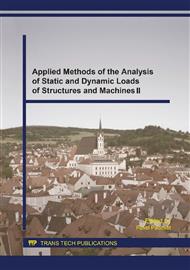[1]
F. Iucolano, B. Liguori, C. Colella, Fibre-reinforced lime-based mortars: A possible resource for ancient masonry restoration, Construction and Building Materials 38 (2013) 785-789.
DOI: 10.1016/j.conbuildmat.2012.09.050
Google Scholar
[2]
A. Izaguirre, J. Lanas, J. I. Alvarez, Effect of a polypropylene fibre on the behaviour of aerial lime-based mortars, Construction and Building Materials 25 (2011) 992-1000.
DOI: 10.1016/j.conbuildmat.2010.06.080
Google Scholar
[3]
A. Gameiro et al., Physical and chemical assessment of lime-metakaolin mortars: Influence of binder: aggregate ratio, Cement & Concrete Composites 45 (2014) 264-271.
DOI: 10.1016/j.cemconcomp.2013.06.010
Google Scholar
[4]
V. Nežerka et al., Comprehensive study on mechanical properties of lime-based pastes with additions of metakaolin and brick dust, Cement and Concrete Research 64 (2014) 17-29.
DOI: 10.1016/j.cemconres.2014.06.006
Google Scholar
[5]
E. Vejmelkova et al., Mechanical, fracture-mechanical, hydric, thermal, and durability properties of lime-metakaolin plasters for renovation of historical buildings, Construction and Building Materials 31 (2012) 22-28.
DOI: 10.1016/j.conbuildmat.2011.12.084
Google Scholar
[6]
J. Fladr et al., Effect of Creep of Polymeric Fibres on Deformation of Fibre Concrete Beam Elements under the Long-Term Loading, in.: T. Dvorsky et al. (Eds. ), 6TH International Conference Fibre Concrete on Technology, Design, Application, Prague 2011, pp.357-364.
Google Scholar
[7]
M.L. Santarelli, Basalt fiber reinforced natural hydraulic lime mortars: A potential bio-based material for restoration, Materials and Design 63 (2014) 398–406.
DOI: 10.1016/j.matdes.2014.06.041
Google Scholar
[8]
M. Prinosil, P. Kabele, Prediction of the Behavior of Lime Mortar Reinforced with Fibers based on their Micromechanical Parameters, in: J. Jasienko (Eds. ), Structural Analysis of Historical Constructions, Wroclaw, 2013, p.883–889.
Google Scholar
[9]
S.E. Elsaka, Influence of Chemical Surface Treatments on Adhesion of Fiber Posts to Composite Resin Core Materials, Dental Materials 29 (2013) 550-558.
DOI: 10.1016/j.dental.2013.03.004
Google Scholar
[10]
D. Cokeliler et al., Modification of Glass Fibers to Improve Reinforcement: A Plasma Polymerization Technique, Dental Materials 23 (2007) 335-342.
DOI: 10.1016/j.dental.2006.01.023
Google Scholar
[11]
Saint-Gobain, Cem-FIL Reinforcements, Anti-Crack, Anti-Crack HD, Product Information. Information on http: /www. sklocement. cz/Anti-Crak. pdf.
Google Scholar


